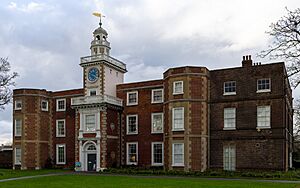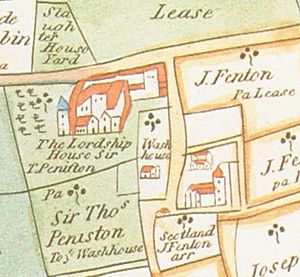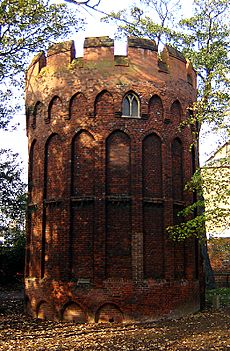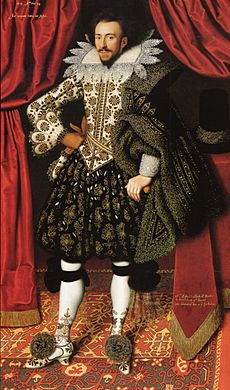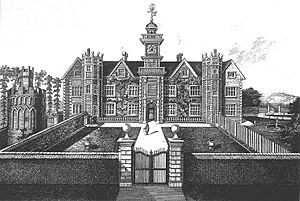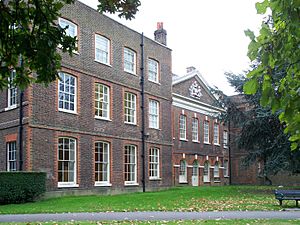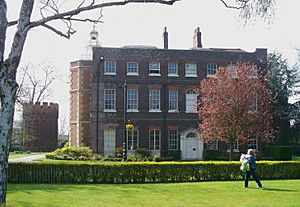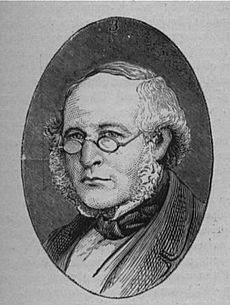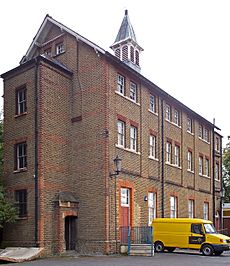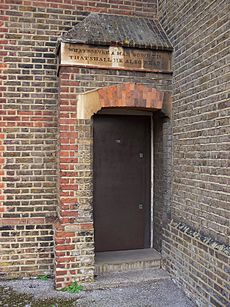Bruce Castle facts for kids
Bruce Castle, also known as the Lordship House, is a very old manor house in Tottenham, London. It was built in the 1500s and is one of the oldest brick houses still standing in England! The castle is named after the Bruce family, who used to own the land a long time ago.
Over the years, the house has been changed and updated many times. Famous people like Sir William Compton, the Barons Coleraine, and Sir Rowland Hill have lived there. For a while in the 1800s, it was even a school! Today, Bruce Castle is a museum. It tells the story of the local area, which is now called the London Borough of Haringey. Because Sir Rowland Hill, who invented postage stamps, lived there, the museum also has exhibits about the history of mail. The building also keeps important historical documents for the area. The land around the castle became Tottenham's first public park in 1892.
Contents
Why is it called Bruce Castle?
The name Bruce Castle comes from the House of Bruce, a famous Scottish family. They owned part of the land in Tottenham many centuries ago. However, there was never actually a castle here, and the Bruce family probably didn't live in this exact spot. When Robert I became King of Scotland in 1306, he lost his lands in England, including the Tottenham property. This ended the Bruce family's connection to the area.
For a long time, the building was called the Lordship House. The name Bruce Castle only started being used much later, around the late 1600s, by Henry Hare, the 2nd Baron Coleraine.
What does Bruce Castle look like?
Next to the main house, there's a round brick tower. Many people think this tower is the oldest part of the building. It's about 21 feet (6.4 meters) tall with very thick walls. In 2006, digging showed that the tower goes deep underground. In the past, it was used as a dairy and was built over a deep well.
Historians aren't completely sure when the house was first built. Some clues suggest parts of it might be from the 1400s. Others think it was built around 1514 or even later in the 1500s. The front of the house has been changed a lot over time. It's made of red brick with stone corners and tall windows. Bruce Castle and its tower are some of the earliest English houses to be built mainly with brick.
Changes to the House Over Time
In 1684, Henry Hare, the 2nd Baron Coleraine, made big changes to the house. He made the ends of the house taller and rebuilt the main entrance with stone decorations and a small tower on top.
Later, in the early 1700s, Henry Hare, the 3rd Baron Coleraine, added more rooms to the north side of the house. He also put the Coleraine family's coat of arms (a special family symbol) on the front. In the late 1700s, when James Townsend owned the house, the narrow east side was changed to become the main entrance, looking like a typical Georgian house. The gabled roofs on the south side were also removed, giving it the look it has today.
In the early 1800s, the west side of the house was taken down, making it look a bit uneven, which it still does today. When the house became a school, a large three-story addition was built in 1870 on the northwest side.
Recent digs in 2006 found the foundations of an even older building on the site, but not much is known about it. Old records from 1742 mention fixing a drawbridge, which suggests the building might have had a moat (a ditch filled with water) around it at one point.
Who lived in Bruce Castle?
It's thought that Sir William Compton was the first owner of the house. He was an important person in King Henry VIII's court and bought the land in Tottenham in 1514. However, there's no clear proof that he actually lived in the house.
The earliest definite mention of the building is from 1516, when King Henry VIII met his sister, Margaret, Queen of Scots, at "Maister Compton's House beside Tottenham." The Compton family owned the building throughout the 1500s.
In the early 1600s, Richard Sackville, the 3rd Earl of Dorset, owned the house. He had many debts from gambling. He leased the house, which was still called "The Lordship House," to Thomas Peniston. Later, the house was sold to Hugh Hare, a wealthy landowner from Norfolk.
The Hare Family in the 1600s
Hugh Hare, 1st Baron Coleraine
Hugh Hare (1606–1667) inherited a lot of money. He married the daughter of Henry Montagu, a powerful earl, which helped him become important in society. He bought the manor of Tottenham, including the Lordship House, in 1625 and soon became Baron Coleraine.
Hugh Hare was close to King Charles I. When the English Civil War started, his wealth declined. His other homes were taken by the Parliament's forces. He passed away in 1667 and his son, Henry Hare, became the next Baron Coleraine.
Henry Hare, 2nd Baron Coleraine
Henry Hare (1635–1708) moved into the Lordship House and renamed it Bruce Castle. He did this to honor the old connection between the area and the Bruce family. Henry Hare was also a historian and wrote the first history of Tottenham. He made many changes to the house in 1684. The central tower with its viewing platform was a popular design at the time.
The Story of the Ghostly Lady
There's an old story about a ghost at Bruce Castle. The earliest mention of this ghost was in 1858, almost 200 years after the events supposedly happened. The story says that one of the Lords Coleraine had a beautiful wife. He became very angry with her and locked her away in the small rooms of the clock tower. One night, she supposedly escaped and jumped from the top of the tower with her baby. The story says that every year in November, her ghostly form can be seen, and her sad cry can be heard. However, this legend is mostly forgotten now, and there haven't been any recent sightings of the ghost.
Residents in the 1700s
Henry Hare, the 2nd Baron Coleraine, passed away in 1708. His grandson, Henry Hare, the 3rd Baron Coleraine, took over. This Henry Hare was a keen historian and spent a lot of time traveling in Europe, so he only lived at Bruce Castle for short periods.
The house was changed again under his ownership. More rooms were added to the north, and the Coleraine family's coat of arms was put on the front of the north side.
Henry Hare's only child, Henrietta Rosa Peregrina, was born in France in 1745. When Henry Hare died in 1749, he left his properties, including Bruce Castle, to Henrietta. However, because she was French, her claim was challenged. After many years, the properties were given to her husband, James Townsend, whom she married when she was 18.
James Townsend was an important person in London. He was a magistrate, a Member of Parliament, and in 1772, he became the Lord Mayor of London. Henrietta was also a talented artist, and many of her pictures of Tottenham from the 1700s are now in the Bruce Castle Museum.
Under James Townsend's ownership after 1764, the house was changed again. The narrow east side became the main entrance and looked like a typical Georgian house. The gabled roofs on the south side were removed, giving it the look it has today.
James and Henrietta Townsend's son, Henry Hare Townsend, wasn't very interested in the area. After renting out the house to different people, he sold Bruce Castle and its land in 1792 to Thomas Smith.
John Eardley Wilmot
John Eardley Wilmot (1749–1815) was a Member of Parliament. In 1783, he led a group in Parliament that looked into the reasons for the American Revolution. He also helped the 60,000 American Loyalists (people who supported Britain) who came to England after the United States became independent. He helped them get compensation and find homes and food.
When the French Revolution began in 1789, many more refugees came to England. Wilmot, along with others like William Wilberforce, started "Wilmot's Committee." This group raised money to help French refugees find places to live, food, and jobs. Many of these refugees settled in the Tottenham area.
In 1804, Wilmot stopped working in public life and moved to Bruce Castle. He wrote his memories about the American Revolution there. He passed away in 1815. After his death, a London merchant named John Ede bought the house and its land. He then took down the west side of the building.
The Hill School
In 1827, Rowland Hill and his brothers opened a branch of their family's school at Bruce Castle, with Rowland Hill as the headmaster. The school had very modern ideas for its time. Teachers focused on helping students want to learn, rather than just giving them facts. Physical punishment was not allowed. Instead, students who broke rules were tried by a court made up of other students. The school taught subjects like foreign languages, science, and engineering. Sons of diplomats and even the sons of Charles Babbage, a computing pioneer, attended the school.
In 1839, Rowland Hill became the head of the General Post Office. He is famous for introducing the world's first postage stamps! His younger brother, Arthur Hill, then took over the school.
During the time the school was open, the area around Bruce Castle changed a lot. Tottenham used to be small villages surrounded by farms. But when new railways were built in the 1840s and 1870s, it became much easier to travel from Tottenham to central London. This led to Tottenham growing into a big residential and industrial area. By the late 1800s, the only undeveloped parts left were the grounds of Bruce Castle and some marshy areas.
In 1877, Birkbeck Hill retired, ending his family's connection with the school. The school closed in 1891. Tottenham Council then bought the house and its land. The grounds opened as Bruce Castle Park in June 1892, becoming Tottenham's first public park. The house itself opened as Bruce Castle Museum in 1906.
Bruce Castle Today
Today, Bruce Castle is a museum. It holds the historical records for the London Borough of Haringey. It has a permanent exhibit about the past, present, and future of Haringey, as well as temporary displays on local history. Other exhibits include a section on Rowland Hill and the history of mail, a collection of old photographs, and historical documents about the area.
In 1949, Bruce Castle was given a special Grade I listing, meaning it's a very important historical building. The round tower was also listed separately. The park's old walls from the 1600s were listed in 1974. From 1969, the castle was also home to the museum of the Middlesex Regiment, but their collection later moved to the National Army Museum. The museum also has a significant collection of paintings by Beatrice Offor.
In July 2006, a big archaeological dig took place in the grounds. Many local young people took part. They found many everyday objects and the chalk foundations of what seems to be an even older house on the site.
In 2012, the park was used for an art project called PARK ART. An artist named Ben Long created a nine-meter-tall lion sculpture out of builder's scaffolding. This large sculpture was placed on the front lawn of the museum. It was a nod to the traditional lion statues found at stately homes and also to the lion symbol of Robert the Bruce, connecting to the castle's history.
See also
 In Spanish: Castillo de Bruce para niños
In Spanish: Castillo de Bruce para niños


